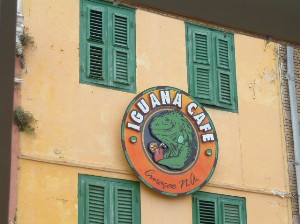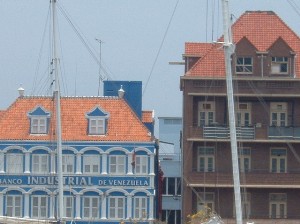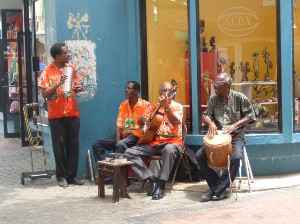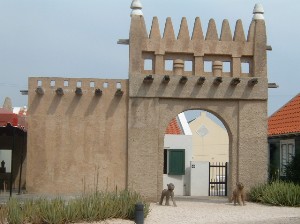Special Feature: Products Sally Recommends
The Culinary Pleasures of Curacao
 Many people have never even heard of Curaçao, except in reference to that blue liqueur used to make Blue Hawaiis. Thirty-seven miles long and less than seven miles wide, Curaçao sits quietly in the Caribbean, calm and serene below the hurricane belt. Its biggest global role is in the oil industry, refining oil from South America for the Royal Dutch/Shell Company. Oh, yes, and they do export that eponymous liqueur (which, incidentally, comes in other colors besides blue) and Amstel beer. Claimed by the Netherlands in the 1600s, the most defining period for this tiny country was the 17th and 18th centuries, when Curaçao was a major slave trading port, which changed the island permanently in customs, language, and food.
Many people have never even heard of Curaçao, except in reference to that blue liqueur used to make Blue Hawaiis. Thirty-seven miles long and less than seven miles wide, Curaçao sits quietly in the Caribbean, calm and serene below the hurricane belt. Its biggest global role is in the oil industry, refining oil from South America for the Royal Dutch/Shell Company. Oh, yes, and they do export that eponymous liqueur (which, incidentally, comes in other colors besides blue) and Amstel beer. Claimed by the Netherlands in the 1600s, the most defining period for this tiny country was the 17th and 18th centuries, when Curaçao was a major slave trading port, which changed the island permanently in customs, language, and food.
Thirty-five miles north of Venezuela, this desert island is one of the most welcoming to tourists you’re likely to find. Overlooked by most Americans in favor of other Caribbean locales, such as Jamaica, Puerto Rico and the Virgin Islands, Curaçao boasts a quiet splendor and a more refined way of life. Being a member of the Netherlands Antilles’ ABC islands (the others being Aruba and Bonaire), about 40 percent of their tourists are European, especially Dutch. Consequently, the atmosphere is Old World. This is perpetuated by the Colonial Dutch décor, which permeates the entire island. Just look around at the pastel-colored plantation homes and the tiled roofs of the public buildings as you walk along the cobblestone streets and you will feel as if you have stepped back in time—and gone across the Atlantic to Holland! Notice I called this a desert island, as opposed to tropical. You will not see many palm trees (those that exist were most likely planted), but you’ll see plenty of cacti, aloe, and divi divi trees. The people, warm, friendly and polite, are a conglomeration of influences. The majority of them speak four languages—Dutch (the official language), Spanish, English, and Papiamentu. Papiamentu itself is a blend of Dutch, Portuguese, Spanish, and African languages.
 But aside from architecture and language, Curaçao has culinary wisdom to impart. Although much of the food on Curaçao is imported—the arid landscape is not conducive to growing much produce—the cuisine is considered one of the best in the Caribbean. Heavily influenced by not only Africans and Dutch, Curaçaoan food has been enhanced by the Jewish population there as well. Having been expelled from Portugal, Jews settled on Curaçao and have been major participants in the cultural and business growth of the country, and their culinary practices blended in with those of the island. As a result, Curaçaoan cuisine has its own style and nuances.
But aside from architecture and language, Curaçao has culinary wisdom to impart. Although much of the food on Curaçao is imported—the arid landscape is not conducive to growing much produce—the cuisine is considered one of the best in the Caribbean. Heavily influenced by not only Africans and Dutch, Curaçaoan food has been enhanced by the Jewish population there as well. Having been expelled from Portugal, Jews settled on Curaçao and have been major participants in the cultural and business growth of the country, and their culinary practices blended in with those of the island. As a result, Curaçaoan cuisine has its own style and nuances.
What can probably be dubbed the signature dish of Curaçao is keshi yená, or “stuffed cheese.” This dish is traditionally made with chicken, vegetables, seasonings, and raisins, which are stuffed into a scooped-out Edam or Gouda cheese shell. The “top” of the cheese is replaced and the whole is baked for at least an hour. In Colonial times, the Dutch masters would eat the cheese and “generously” donate the shell to their workers, and having to make due with what they had, the poor people of the island came up with this specialty. It is not only visually striking but unusually savory and redolent of Dutch influence. It is a “homey” dish that not many restaurants offer; however, if you look hard enough, you’ll find a few places that do serve it. Gouverneur de Rouville serves a slightly “fancied-up” version, baked in individual casserole dishes, and made with prunes and peppers. It is filling, sweetly aromatic, and oozing with a thick cheese top.
 Two very popular dishes on Curaçao—and throughout the Antilles—are funchi and tutu. Both based on cornmeal, they are commonly served as side dishes or appetizers. Taken directly from African cuisine, these two dishes are still cooked in the traditional manner. Funchi is much like polenta, in that cornmeal is poured and stirred into boiling water seasoned with butter and salt. It is stirred with a spoon-like utensil calle a mealie or funchi stick. It is most often left mushy and served in a mound, although sometimes it is allowed to stiffen and then shaped into dumplings, much like U.S. hushpuppies. Some fancy eateries will shape the funchi into ramekins or other molds. Tutu is like funchi but with the addition of mashed black-eyed peas and is mixed with a lélé. Bitterbal is also a popular Dutch-inspired dish. It is sausage meat formed into balls, coated in bread crumbs and fried, and is eaten for breakfast, lunch and snacks. Bitterbal and other Dutch specialties can be had at the conveniently located Iguana Café, which sits alongside St. Anna Bay.
Two very popular dishes on Curaçao—and throughout the Antilles—are funchi and tutu. Both based on cornmeal, they are commonly served as side dishes or appetizers. Taken directly from African cuisine, these two dishes are still cooked in the traditional manner. Funchi is much like polenta, in that cornmeal is poured and stirred into boiling water seasoned with butter and salt. It is stirred with a spoon-like utensil calle a mealie or funchi stick. It is most often left mushy and served in a mound, although sometimes it is allowed to stiffen and then shaped into dumplings, much like U.S. hushpuppies. Some fancy eateries will shape the funchi into ramekins or other molds. Tutu is like funchi but with the addition of mashed black-eyed peas and is mixed with a lélé. Bitterbal is also a popular Dutch-inspired dish. It is sausage meat formed into balls, coated in bread crumbs and fried, and is eaten for breakfast, lunch and snacks. Bitterbal and other Dutch specialties can be had at the conveniently located Iguana Café, which sits alongside St. Anna Bay.
 Another treat that can be found in the Antilles is the rijstafel. Literally translated, this is a “rice table,” on which a buffet is set up with numerous dishes (anywhere from 10 to 25!) that are accompanied by rice. This was introduced by the Dutch, who in turn, picked it up from Indonesia, where they also ruled. Condiments are laid out on your table and you can season the food to your liking. If you’re the adventurous type, you might try something that is considered healthy fare on the island: Sopi di yuana, or iguana stew. It is believed that it will make sick people well and young men strong. Iguanas may look like prehistoric creatures, but word on the street is that they taste like chicken! I’ll spare you the iguana stew recipe but I’ll share with you recipes for keshi yená, funchi, and tutu.
Another treat that can be found in the Antilles is the rijstafel. Literally translated, this is a “rice table,” on which a buffet is set up with numerous dishes (anywhere from 10 to 25!) that are accompanied by rice. This was introduced by the Dutch, who in turn, picked it up from Indonesia, where they also ruled. Condiments are laid out on your table and you can season the food to your liking. If you’re the adventurous type, you might try something that is considered healthy fare on the island: Sopi di yuana, or iguana stew. It is believed that it will make sick people well and young men strong. Iguanas may look like prehistoric creatures, but word on the street is that they taste like chicken! I’ll spare you the iguana stew recipe but I’ll share with you recipes for keshi yená, funchi, and tutu.
Bon Probecho!
KeshiYená (Stuffed Cheese)
Adapted from The Jewish Kitchens of Curaçao
1 small Edam cheese (2 to 2½lbs)
2 lbs. shredded cooked chicken
3 tomatoes, chopped and peeled
2 sliced onions
1 garlic clove
1 chopped green pepper
¼ cup sliced olives
1 tablespoon capers
1 tablespoon parsley
¼ minced hot pepper (or hot sauce to taste)
½ cup raisins and chopped prunes
1 tablespoon tomato paste
2 teaspoons Worcestershire sauce
2 tablespoons ketchup
2 tablespoons mustard
Salt and pepper to taste
2 tablespoons butter
5 eggs
Slice the top off the cheese and reserve. Gently scoop out the inside, leaving a 1/4 to 1/2 inch shell. The cheese should resemble a hollowed out pumpkin. Sauté the remaining ingredients, except the eggs, in the butter; simmer for about 20 minutes. Beat 4 eggs and stir into the mixture. Spoon it into the cheese shell, replace the top and spread remaining beaten egg on top to seal. Grease a shallow baking dish and fill it with about 1 inch of water; set the cheese in the dish and bake at 350° F for 1 to 11/2 hours. The cheese will expand and flatten slightly but will keep its basic shape. Serve piping hot, cut into wedges. Leftovers are good reheated.
Funchi (Corn Meal Mush)
Adapted from The Jewish Kitchens of Curaçao
1 1/2 cups cold water
1 cup corn-meal
1 teaspoon salt
1/2 cup boiling water
1 tablespoon butter or margarine
Mix the cold water, corn-meal and salt in a heavy saucepan. Stir in the boiling water and butter or margarine. Bring to a boil and cook for about 3 minutes. Continue for another 3 minutes while stirring with a wooden spoon. Mixture is done when it pulls away from the sides of the pan and it is stiff in texture. Remove from heat and serve immediately.
Serves 4 to 6.
Tutu (Corn Meal With Black Eyed Peas)
Adapted from The Jewish Kitchens of Curaçao
1 cup corn-meal
16 oz. packaged dry black-eyed peas
6 cups water
3 cups water
1/4 cup sugar
1 teaspoon salt
3 cups funchi or corn-meal
4 tablespoons butter or margarine
Cook the black-eyed peas in the 6 cups water until soft. Drain.
Add 3 cups of water to the peas and bring to a boil, then use a whisk or "lele stick" to break the peas. Add sugar and salt and whisk again. Taste for seasoning, and adjust if necessary.
Add corn-meal, and in a combination of beating and mashing the mixture, blend it well to avoid lumps using a wooden spoon. Reduce heat. Continue the beating/mashing technique until the meal disappears and the mixture pulls away from the sides of the pan. Add butter when done and either invert on a platter or use an ice cream scoop (dipped in water before each scoop) for individual portions. Serve with butter and cheese.
Gouverneur de Rouville
Gouverneur de Rouvilleweg 9-f
Tel: +(5999)/462-5999
Iguana Café
Handelskad
Tel: +(5999)/461-9866
Note: This information was accurate when it was published. Please be sure to confirm all rates and details directly with the businesses in question before making your plans.



